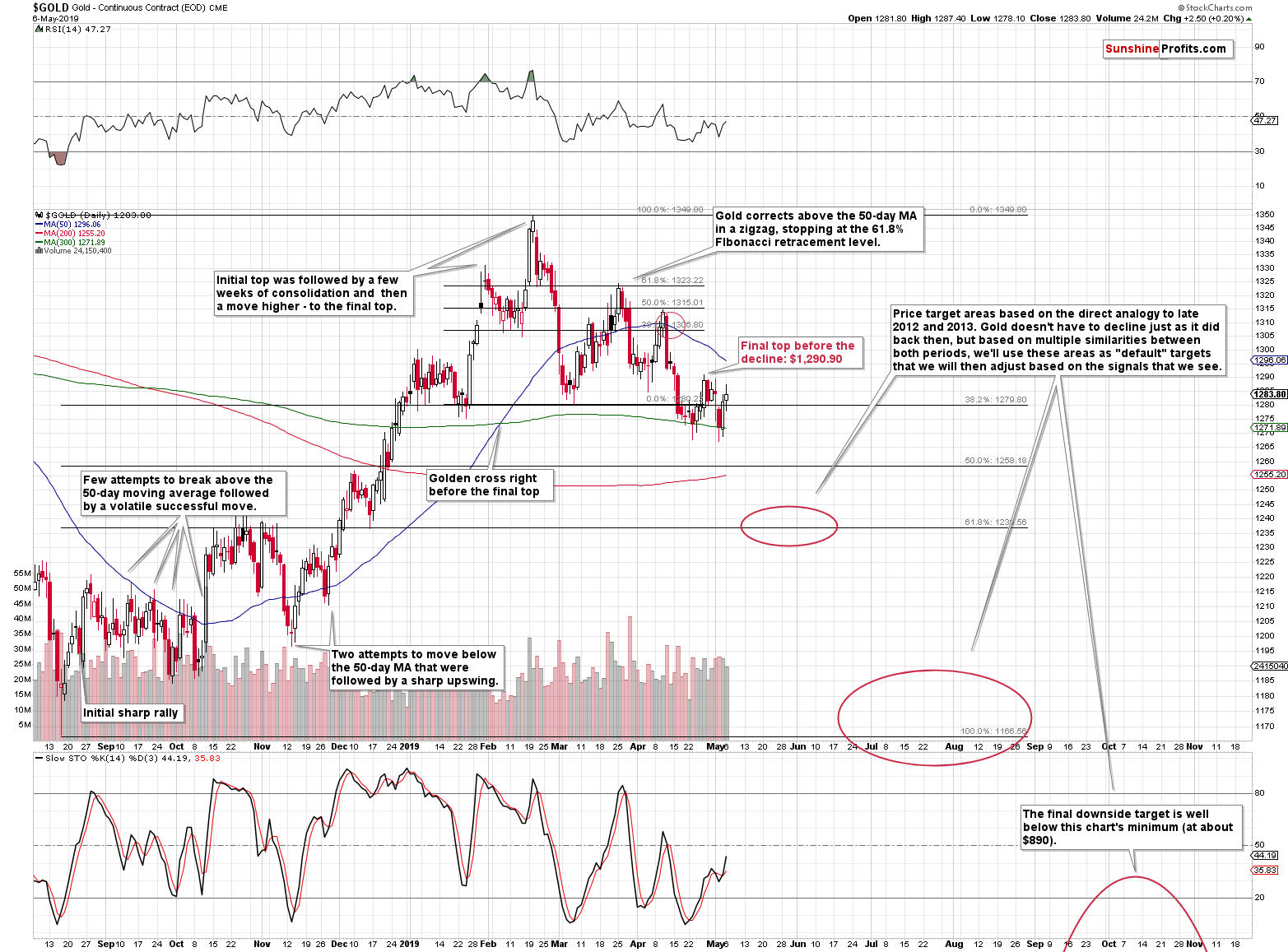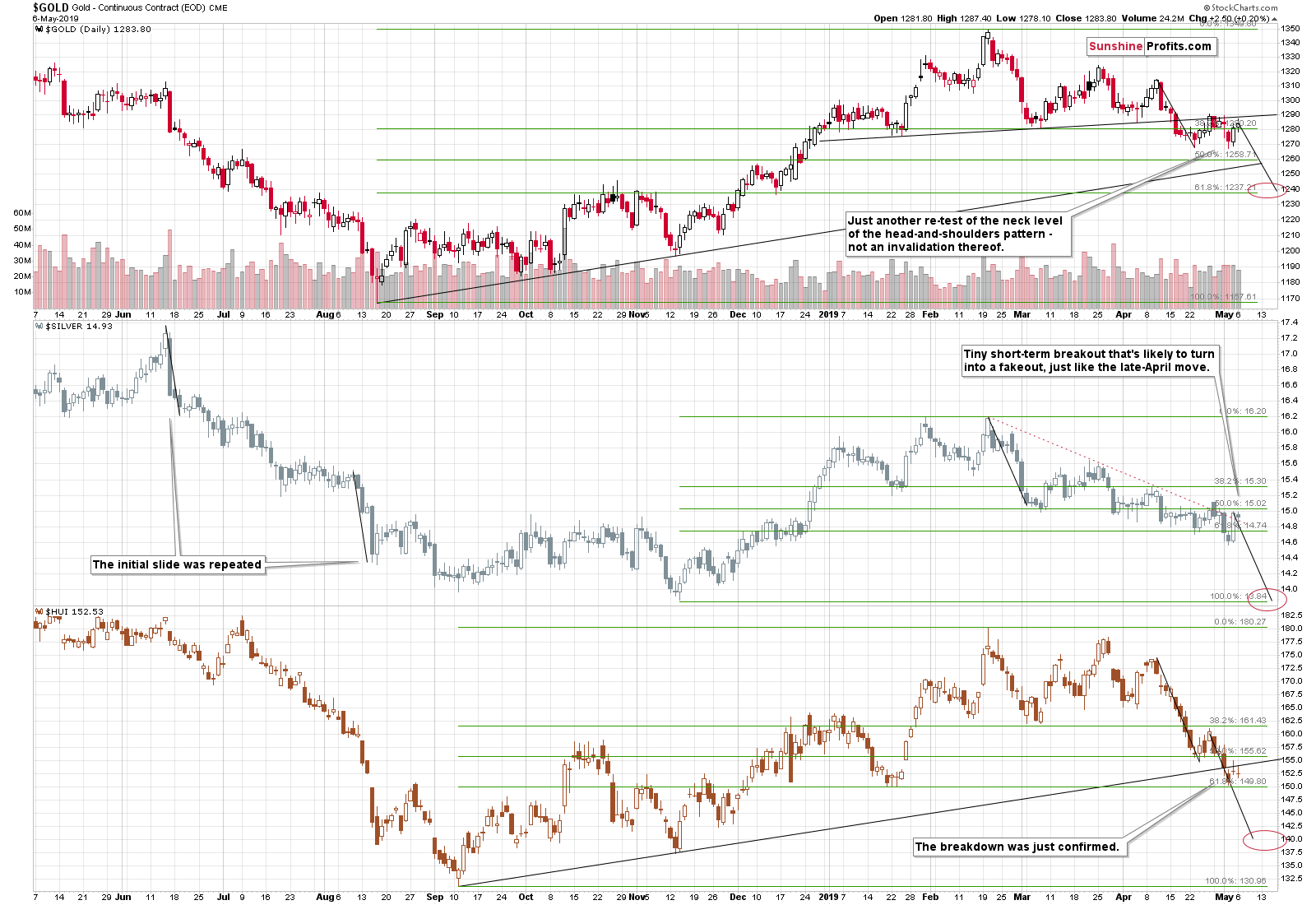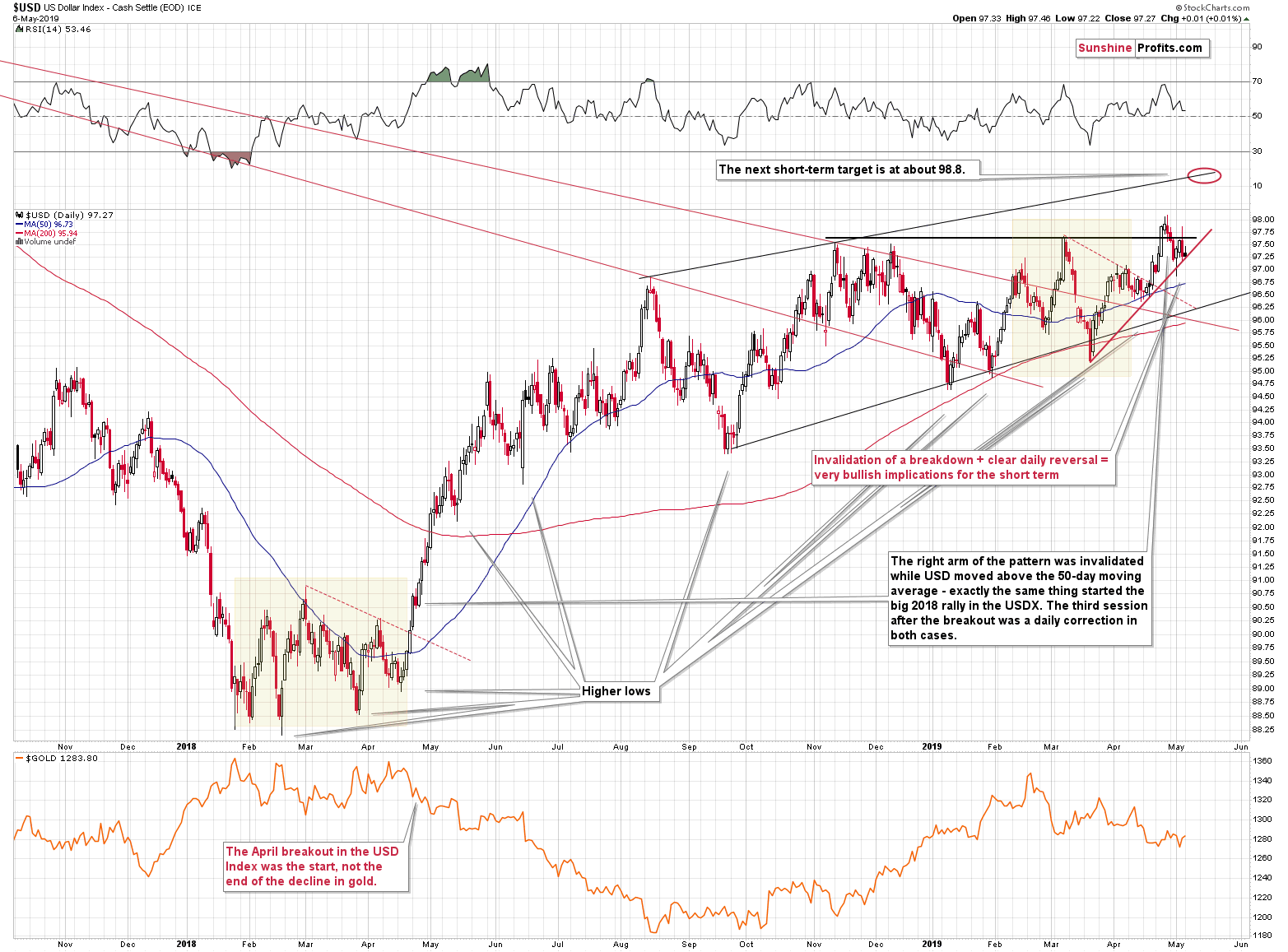Briefly: in our opinion, full (250% of the regular size of the position) speculative short position in gold, silver, and mining stocks is justified from the risk/reward perspective at the moment of publishing this Alert.
You already saw it. You know you did. You just can' t put your finger on it. You're not sure what happened next. But you still have that hunch. Déjà vu happened to most of us, individually. Would you be interested in an entire-precious-metals-market-based déjà vu? That's great, because you are already participating. And the best thing about it that this time you'll know what happens next. We'll tell you.
You already know that the precious metals market is about to decline, and our previous Alerts already included precise near-term downside targets. The additional timely detail that we get based on the above-mentioned déjà vu analysis is a special confirmation that we're likely to see that the bottom is in. This should help us take the profits off the table without unnecessarily limiting them, even if not all of our targets are reached on the same day.
In the previous Alerts, we explained how similar the current situation is to what happened in 2012 and 2013. There are multiple long-term and short-term links that we have used to create our gold price forecast for 2019. What we haven't previously discussed was how all three key parts of the precious metals market come together in light of this analogy. Today, we're going to do exactly that.
Let's start with gold's 2012-2013 chart as a reminder where gold currently is in light of the analogy.
Revisiting the 2012-2013 - Now Link's Implications
Gold is currently trading a bit above the 38.2% Fibonacci retracement level based on the entire previous upswing and it's also close to the previous lows. This makes the current situation similar to what we saw in mid-December 2012, right before the decline accelerated. In fact, the day-to-day volatility was even lower than it is right now. One should not be fooled by this lack of volatile moves - in December, gold plunged quite dramatically right after a few days of boring back-and-forth movement. Gold is currently more volatile, but it's quite natural given the surprising nature of the employment numbers.
Let's add silver and mining stocks to the above picture.
To make the comparison easier, we marked the current and upcoming move with a yellow rectangle.
As we wrote earlier, gold is trading a bit above its 38.2% Fibonacci retracement. In 2012, silver was trading at similar levels as well. This time, silver is lower. Silver's underperformance this year is something normal given the recent breakout in the gold to silver ratio.
Both: gold, and silver are currently trading close to their previous lows, just like what we saw in December 2012, before the volatile decline.
Gold stocks are trading close to the bottom that was followed by the final part of the upswing. In 2012, that was the late-August bottom, and right now it's the January 2019 bottom.
There is some relative similarity in the shapes of the declines. After the final top, the 2019 decline in the miners has been relatively smooth and steady. Miners didn't decline very sharply in a single day, but rather by taking one step lower at a time. Gold and - especially - silver were more volatile on a very short-term basis. We saw the same thing in 2012, but on a wider scale. The decline that started in September and October 2012 was smoother and steadier in case of the mining stocks.
Now, what does this multi-market similarity tell us with regard to the upcoming slide? It tells us that we might see a very specific session that temporarily ends to decline. Gold, and silver declined profoundly on the last day of the decline, while miners did something uncanny.
Miners reversed and closed higher than they had opened. The December 20, 2012 reversal marked the end of the decline. The following day was also a great opportunity to temporarily exit short positions or enter long ones, but the history doesn't have to repeat to the letter, so it may not be a good idea to delay the adjustment of the trading positions.
Consequently, if gold, silver and/or mining stocks are very close or at their respective targets but not all of them are reached at the same time, but we see a confirmation from the mining stocks - they reverse and close the day above the opening price - we'll likely temporarily close the current short positions and take profits off the table. We might also enter long positions at that time.
On a side note, please note how well the triangle-vertex-based reversal technique worked in 2012 - gold, silver and miners practically ended the rally right at the vertex of the triangle (mid-September 2012). That was not the exact top, but it was the day when the rally lost its momentum. It was an excellent opportunity to exit long and/or enter short positions.
As far as yesterday's price moves are concerned, we would like to emphasize three things.
First, the tiny breakout in silver is nothing bullish - it was not confirmed by anything similar in gold or miners, so it's most likely a regular silver fakeout, similar to the one that we saw in late April.
Second, the HUI Index has just confirmed the breakdown below the rising support/resistance line by closing below it for three consecutive trading days. The implications are very bearish.
Third, gold stocks once again underperformed gold, by declining while gold moved higher. This is yet another clear sign that the precious metals sector is about to slide.
Before summarizing, let's take a look at the USD Index.
Refreshing the USD Picture
The important thing about the U.S. currency is that it's still trading above the rising red support line. The USDX is therefore not repeating the early March performance, when it declined sharply shortly after invalidating the breakout above the previous highs. Instead, the USDX appears getting ready to launch another attack on this resistance. Will it be successful? It's quite likely and gold is well positioned to respond to such action with a powerful slide. After all, gold has already confirmed and verified (twice) the breakdown below the neck level of its head-and-shoulders pattern.
Summary
Summing up, the link to the 2012-2013 decline continues to support much lower prices in the following months, weeks, and - likely - days. Miners' weakness and confirmation of breakdown is a clear sign that the next big move lower is already underway and that another short-term slide is at hand. The next short-term bottom might be reached as early as this week - in a volatile manner. This upcoming bottom might be a good opportunity to go long, but we are definitely not in this kind of situation right now. Conversely, in our view, short positions are likely to generate sizable profits.
To summarize:
Trading capital (supplementary part of the portfolio; our opinion): Full short position (250% of the full position) in gold, silver, and mining stocks is justified from the risk/reward perspective with the following stop-loss orders and exit profit-take price levels:
- Gold: profit-take exit price: $1,241; stop-loss: $1,357; initial target price for the DGLD ETN: $51.87; stop-loss for the DGLD ETN $39.87
- Silver: profit-take exit price: $13.81; stop-loss: $15.72; initial target price for the DSLV ETN: $39.38; stop-loss for the DSLV ETN $26.97
- Mining stocks (price levels for the GDX ETF): profit-take exit price: $18.41; stop-loss: $24.17; initial target price for the DUST ETF: $34.28; stop-loss for the DUST ETF $15.47
In case one wants to bet on junior mining stocks' prices (we do not suggest doing so - we think senior mining stocks are more predictable in the case of short-term trades - if one wants to do it anyway, we provide the details), here are the stop-loss details and target prices:
- GDXJ ETF: profit-take exit price: $26.42; stop-loss: $35.67
- JDST ETF: profit-take exit price: $78.21 stop-loss: $30.97
Long-term capital (core part of the portfolio; our opinion): No positions (in other words: cash)
Insurance capital (core part of the portfolio; our opinion): Full position
Whether you already subscribed or not, we encourage you to find out how to make the most of our alerts and read our replies to the most common alert-and-gold-trading-related-questions.
Please note that the in the trading section we describe the situation for the day that the alert is posted. In other words, it we are writing about a speculative position, it means that it is up-to-date on the day it was posted. We are also featuring the initial target prices, so that you can decide whether keeping a position on a given day is something that is in tune with your approach (some moves are too small for medium-term traders and some might appear too big for day-traders).
Plus, you might want to read why our stop-loss orders are usually relatively far from the current price.
Please note that a full position doesn't mean using all of the capital for a given trade. You will find details on our thoughts on gold portfolio structuring in the Key Insights section on our website.
As a reminder - "initial target price" means exactly that - an "initial" one, it's not a price level at which we suggest closing positions. If this becomes the case (like it did in the previous trade) we will refer to these levels as levels of exit orders (exactly as we've done previously). Stop-loss levels, however, are naturally not "initial", but something that, in our opinion, might be entered as an order.
Since it is impossible to synchronize target prices and stop-loss levels for all the ETFs and ETNs with the main markets that we provide these levels for (gold, silver and mining stocks - the GDX ETF), the stop-loss levels and target prices for other ETNs and ETF (among other: UGLD, DGLD, USLV, DSLV, NUGT, DUST, JNUG, JDST) are provided as supplementary, and not as "final". This means that if a stop-loss or a target level is reached for any of the "additional instruments" (DGLD for instance), but not for the "main instrument" (gold in this case), we will view positions in both gold and DGLD as still open and the stop-loss for DGLD would have to be moved lower. On the other hand, if gold moves to a stop-loss level but DGLD doesn't, then we will view both positions (in gold and DGLD) as closed. In other words, since it's not possible to be 100% certain that each related instrument moves to a given level when the underlying instrument does, we can't provide levels that would be binding. The levels that we do provide are our best estimate of the levels that will correspond to the levels in the underlying assets, but it will be the underlying assets that one will need to focus on regarding the signs pointing to closing a given position or keeping it open. We might adjust the levels in the "additional instruments" without adjusting the levels in the "main instruments", which will simply mean that we have improved our estimation of these levels, not that we changed our outlook on the markets. We are already working on a tool that would update these levels on a daily basis for the most popular ETFs, ETNs and individual mining stocks.
Our preferred ways to invest in and to trade gold along with the reasoning can be found in the how to buy gold section. Additionally, our preferred ETFs and ETNs can be found in our Gold & Silver ETF Ranking.
As a reminder, Gold & Silver Trading Alerts are posted before or on each trading day (we usually post them before the opening bell, but we don't promise doing that each day). If there's anything urgent, we will send you an additional small alert before posting the main one.
Thank you.
Sincerely,
Przemyslaw Radomski, CFA
Editor-in-chief, Gold & Silver Fund Manager








